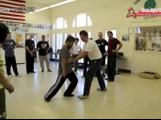I have a question that I hope someone can answer. What is the correct way to stomp when training ? Are there any training exercises we can do to be able to stomp the right way when doing the form? I know that there is a wrong and a right way to stomp. I know that when it is done right it is very powerful. I just want to make sure I’m doing that right.
The stomp
Previous post: Qi Yucheng 2011 Beijing Hunyuan Form
Next post: “Chen Zhonghua Ottawa Workshop Feb. 12, 2012” Online Video Trailer



{ 3 comments… read them below or add one }
As I understand, we don’t pay attention to this in practical method. It is neither emphasized nor prohibited. It’s part of the rotation.
The easier approach to this problem would be how NOT to stomp.
The analogy that i use for the body structure would be a shade house with no walls. It only has one pillar to support the ceiling but it is not exactly in the center; because there is a second short pillar that the ceiling has to counterweight on. The ceiling is your upper body and the pillars are obviously your legs. Note that the short pillar is a retractable arm just like those punching toys that extend and retract.
1) Do NOT squat NOR shift your weight while stomping. The common thinking is to use the body mass and move it down to add force to the stomping leg. Although it is true that it will add force to a certain degree, it has really bad implications. First, you are standing on one leg so your balance is reduced by almost half. Then if you squat or shift your weight, your balance will cripple further.
Imagine the shade house’s pillar bending sideways and the ceiling coming down at you. If someone has a rope or stick connected to the ceiling (your opponent’s hands); he can easily push/pull the building down from where it stands. Otherwise, the building is standing with only one pillar in balance still has a solid structure and will be hard to come down.
2) The source comes from an engine that controls the object NOT the object itself. The easiest example is how Master Chen explains that for pushing hands, the engine is the legs not the hands. The hands makes contact with the opponent but the source is the rear leg. In this case, your contact point is the leg so your engine has to be something other than the legs. If your hands were to be connected to a wall or ceiling then if could borrow other structure to make it into an engine. But since most of the times your hands are in the middle of the air, then it has to come from a different engine.
The answer lies on extending the pillar to your head. Where your head becomes the ceiling. Which is also the basis of the suspended head on the head-spine structure. You stretch down your spine down without squatting which creates what TaiChiQuan calls “sinking the chi”. The analogy is that the retractable pillar is pushing from the ceiling; and the ceiling is pushing against the ground through the supporting pillar. But it cannot be done if you squat or shift your weight. Like if the building is coming down, once you tilt it and the ceiling no longer has the supporting structure the retractable pillar can push on.
3) Once in contact, do NOT push the stomping foot further; land it. The wrong mental image is that you are standing in one leg, and you want to jump with the other leg that is in mid-air. Although at the moment of impact it does increase the power slightly, you have to pull your weight of the supporting leg and become floating in mid-air for a split of a second. This make you loose your balance and structure again. In addition, it causes what Master Chen refers as “protrusion”. An example is in pushing hands, if you push with you hands, you will protrude your back.
The stomp is part of the “An” principle. Push with a release. Meaning you let the energy that has accumulated with the momentum go out. The mental image with the shade house analogy is that once the retractable pillar makes contact with the ground, it disconnects from the ceiling. Because there are still some parts of the retractable pillar that extended in mid-air; the falling of the rest of the pillar creates additional unstoppable force into the ground.
Notes: Try not to stomp with your heel. It is true that because your heel is the most solid part of your foot, it transfer energy better than the calf or your side of your foot. But if you miss and hit the ground the shock goes right back up to your head. Also, the last and more important note is that the ceiling (head) never goes up nor down during the entire process.
For beginners, it is better just land the foot softly. change weight to that foot and do the next move.